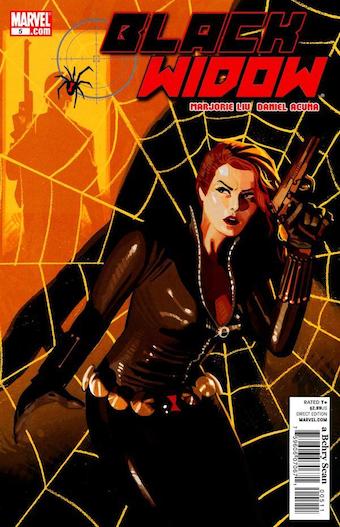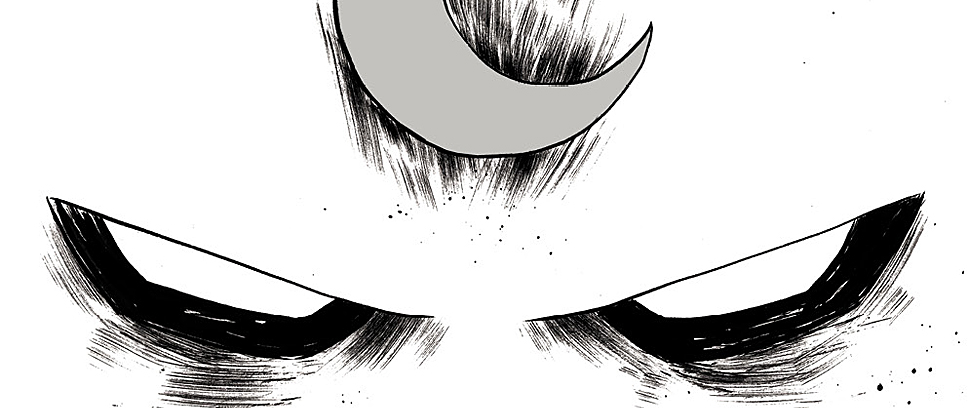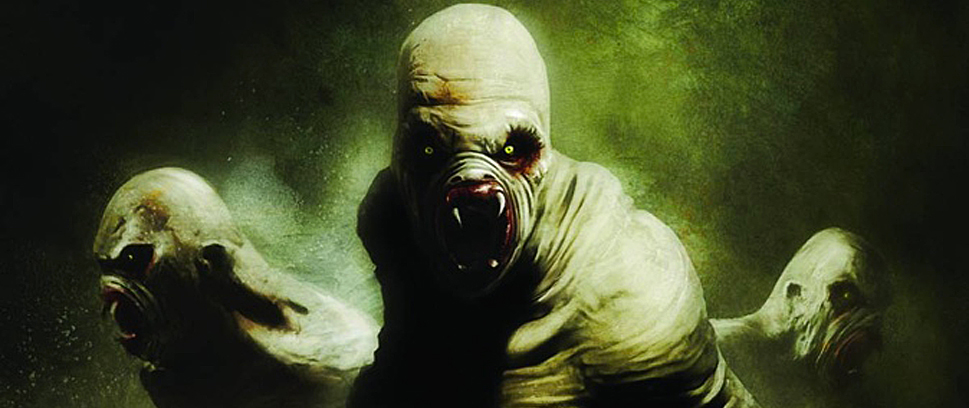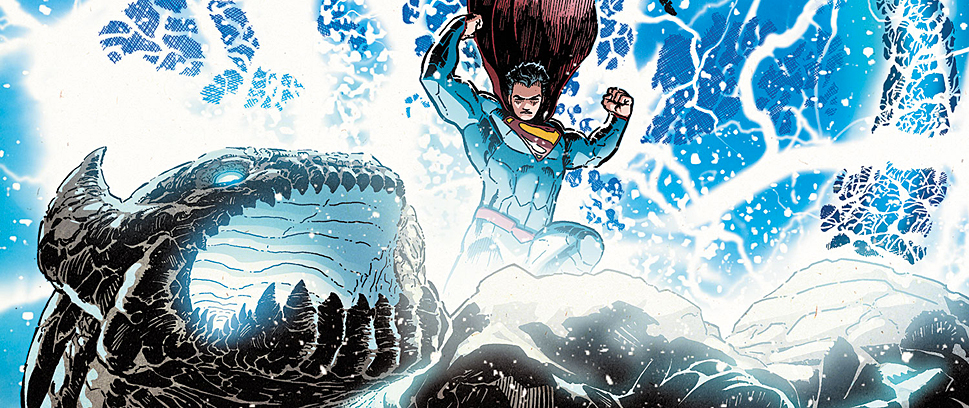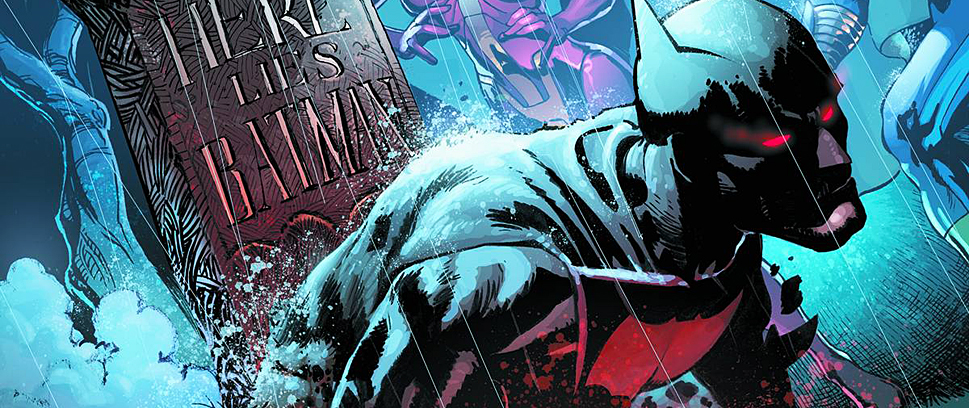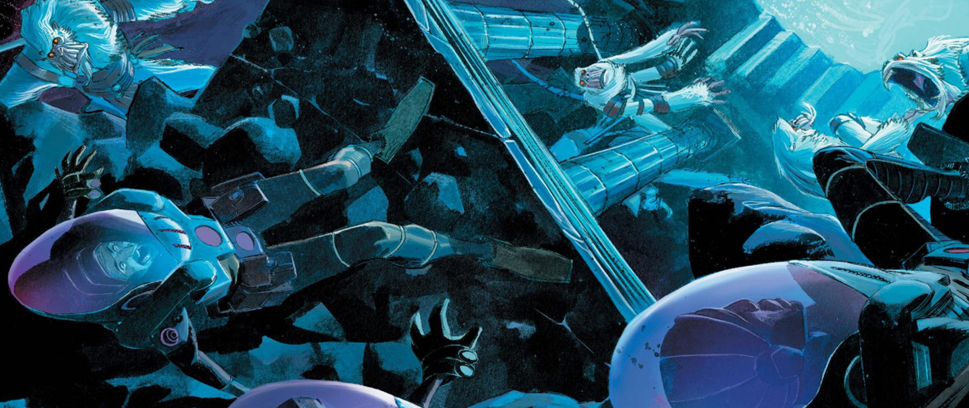
Last Week’s Comics 4/9/2014
Black Science #5
(Image – writer: Rick Remender; art: Matteo Scalera)
Rick Remender sure does love twists and turns.
Black Science #5 finds its characters dealing with a new threat (alternate versions of themselves), and the information they deliver impacts the way readers will look at certain characters as the series goes forward.
 While much of Black Science has been non-stop action and suspense, this issue is a bit slower in the introduction. The comic plods along nicely, but the usual intensity is definitely missed. When Remender does eventually reveal the threat, he races towards the finish line and never fully gives the antagonist enough time to develop.
While much of Black Science has been non-stop action and suspense, this issue is a bit slower in the introduction. The comic plods along nicely, but the usual intensity is definitely missed. When Remender does eventually reveal the threat, he races towards the finish line and never fully gives the antagonist enough time to develop.
The comic is basically of two minds, the first part being heavy exposition and characterization, and the second being a downhill sprint towards a conclusion that raises more questions in an already question heavy series. The latter ends all too abruptly for this reader. I love the new ground Remender covers, as it definitely alters the way we’ll read the series going forward. But the dramatic effect is lost in the shuffle of panels at the end.
While crafting a damn good mystery, Remender still has to conclude his comic in a short span. So where the first half of the issue is graceful, the finale is rushed, almost to a point where Remender should have ended the issue a few pages earlier and then addressed the resolution in a future issue.
The art is crafted with the same methodical pacing at the beginning of the story (larger panels and stationary shots). But towards the end, when Grant has to chase down himself through traffic-laden streets, the intensity picks up, and Matteo Scalera gives the comic the energy it needs. But even his art in the finale is compacted, so that previous pages of only four or five panels are now stuffed with seven or eight panels, each lacking the same kind of detail seen before.
Granted, these are minor flaws given the awesomeness of Black Science, but they definitely detracted from my usual readers’ awe. Remender has a lot of story, and Scalera obliges by giving a lot of visual detail. I just hope that future issues will allow more breathing room so that the great reveals (like those seen in this issue) will elicit stronger reactions.
———
Action Comics #30
 (DC – writer: Greg Pak; art: Aaron Kuder, Jed Dougherty and Karl Kerschl)
(DC – writer: Greg Pak; art: Aaron Kuder, Jed Dougherty and Karl Kerschl)
This issue of Action Comics is a bit frustrating to read. The issue starts strong with Greg Pak giving readers a view of the New 52 Doomsday, a creature who resembles the monster that defeated Superman – but this version of Doomsday is darker, more chaotic. And by the end of the issue, he’s really a complete mystery.
But the issue also starts solidly with Clark narrating a relaxation technique his father taught him. Somewhere along the way, Jonathan Kent told Clark to count to 10 when he was angry. But as we see Superman streak across the sky, a blue and red blur that spans the globe, instead of counting up to 10, Clark says, “I’m up to 10 thousand.”
I’m not doing the delivery justice, but it’s a solid introduction. We see a lot of Clark’s prowess as a tactician when he fights Harrow, a ghost-like commander of an army of the dead. Think the army Aragon summons in The Return of the King and you’ll have an idea of what I’m talking about. So while Superman cannot fight a dead army, he can at least turn them against their master.
The finale is one where Harrow sees what we all see: Clark is too good a person, and his kindness will destroy the world. But did she really have to go through all the trouble just to teach him a schoolboy lesson? I had a hard time buying into what Harrow was working towards, as the explanation just seems so incongruent with the violence that erupts and the mayhem that ensues.
Even the artistic team doesn’t know in which direction to take the story, as the style switches several times. Aaron Kuder’s designs are thickly inked to a point where they make the action look stilted and choppy. The best work comes from the second artist in the group. The editorial staff doesn’t designate who does the illustrations found on pages 8-11, but it’s the best work of the issue – glossy and detailed art that reminds me of Stuart Immonen. It’s beautiful enough that I wish the artist (either Joe Dougherty or Karl Kerschl) would illustrate more Superman books.
I’m glad DC’s bringing back Doomsday, because he’s what drew me into comics. I want to see Clark have a vicious knockdown, drag out with the beast (especially when we see what he’s morphed into at the end of the issue), and Pak is a great writer who can deliver the action (no pun intended) of their battle. He’s also a great writer to have with Superman. But this issue is a weird mix of closure and transition, and the comic never fully finds its footing.
When Pak can focus solely on the upcoming threat, I think the series will regain some of its balance.
———
Magneto #2
 (Marvel – writer: Cullen Bunn; art: Gabriel Hernandez Walta)
(Marvel – writer: Cullen Bunn; art: Gabriel Hernandez Walta)
Bannen’s Book of the Week: Writing a comic about a bad guy doing bad things seems easy. Take your villain, put him out in the world where he can flex his muscles and then let him go to town. Draw blood. Leave bodies in his wake. Make him a mark of fear for all to see.
Cullen Bunn, however, is doing something different. He’s not putting his bad guy out front and center and having him wreak havoc just because he can. No, Bunn’s Magneto is a series that gets inside the mind of its protagonist – a man who happens to want the destruction of the human race – but in a way that doesn’t make him likable or unlikable.
Bunn’s writing, instead, gives up Magneto’s perspective, and this is where the comic is an absolute must read. While we get to see the beginnings of a police investigation involving the events of the previous issue, most of comic devotes itself to Magneto following the trail of the Sentinel that attacked him. This leads him back to a homeless encampment where Magneto learns a more sinister force is at work, one that looks to exploit those dejected by society and use them for personal gain.
The comic also has an inner plot, a story of Max’s survival during Nazi Germany. Focusing on Max and two of his friends trying to bring food to their families, this subplot gives us a bit more knowledge of what makes Magneto tick. What we find out is that Max sees himself as destined to lead and chosen to use his power to fight. It’s a harrowing realization given that the outcome could have been very different in the blink of an eye.
Plus, the finale of Magneto is just awesome. Max uses his skill to stop a group of men who set out to do something that I won’t spoil here, but their end is both gruesome and warranted. I have to confess to enjoying their pain, because they definitely deserved no mercy.
And Gabriel Hernandez Walta crafts every part of the issue with impressive skill and gritty realism. I see his work as akin to Charlie Adlard’s, but with a bit more smoothness. Jordie Bellaire also needs to be praised here, as the drab color tones of Max’s memories bring the story to life with such powerful rendering that they made my heart ache. The symmetry of the ending ties Max’s memories perfectly in with his present-day mission, and readers have a clearer picture of his motivations, regardless of how dark they may be.
This is a fantastic series, and one that demonstrates how writers should make villains into main characters. There’s no empathy, no understanding. Just cold, indifferent facts. And this makes Magneto all the more brilliant.
———
Moon Knight #2
 (Marvel – writer: Warren Ellis; art: Declan Shalvey)
(Marvel – writer: Warren Ellis; art: Declan Shalvey)
I remember reading my older cousin Don’s Doug Moench and Bill Sienkiewicz Moon Knight comics when I was a kid. There was a lot going on in that book. It wasn’t your standard superhero comic. The titular character had multiple personalities and worked as a mercenary. Moon Knight’s white costume stood out in the shadows – like a dare to the monsters and madmen he faced. It wasn’t like any superhero comic I’d read before and it was awesome!
Marvel’s latest take on the cult favorite character comes courtesy of Warren Ellis, Declan Shalvey and Jordie Bellaire. It’s two issues in and Moon Knight #2 is vastly different from the first. Whereas the first issue was about established Moon Knight’s relationship with the police as a more a consulting detective than masked vigilante, the second issue is a full-on superhero story – full of punching, capes and gadgets.
Declan Shalvey and Jordie Bellaire take an introduction that would feel too long and blend the art and colors to build up a game, a game in which a sniper picks off his targets. That game leads into Moon Knight’s involvement.
Last issue, Mr. Knight wore his mask and a bright white suit. This issue, Moon Knight is wearing his full costume and he has his hang glider. He gets into an expertly-crafted fight with the sniper, all while exposition begins to illuminate the clues we saw in the previous pages – the links between the Sniper’s victims. They’re all older, but well to do. The ones with kids seem to be older parents. They’re all talking about foreign markets in some way. And thus the threads are tied together with the last of the sniper’s targets.
One of the more unique aspects of Moon Knight is that he has multiple personalities. In the previous series, he adopted traits of Captain America, Spider-Man and Wolverine in order to accomplish his goals in Los Angeles. This Moon Knight has abandoned those personalities for something as yet unrevealed. This issue’s tonal shift from the first may be a clue as to how Ellis and Shalvey will handle the other sides of Moon Knight. He was a detective in the first issue and a full-on costumed vigilante in this one. That appears to be the game Ellis and company are playing, but we are only two issues in. I am excited to be along for the ride.
– Ian Gonzales
———
(Marvel – Writer: Nathan Edmondson; Artist: Phil Noto)
Black Widow‘s first multi-part storyline kicked off last issue, when Natasha failed to capture a Russian monk-turned-assassin named Molot Boga. Now it’s on.
But Natasha takes down Molot Boga before the issue is even half over, and we move right along to the mystery of the person he was trying to kill. One interrogation and one secret meeting later and now Natasha is jumping out of a S.H.I.E.L.D. helicopter into the ocean, only to realize that her info was bad and she’s swum right into a trap.
The small but numerous panels and large amount of plot made Black Widow #5 seem longer than previous issues, and not as well-paced – or at least it seemed that way to me, reading it digitally panel-by-panel on my smartphone. But issue 5 is not a self-contained story – it’s more concerned with taking us from issue #4 to issue #6 than standing on its own.
As with most spy stories, the spoken dialogue focuses mostly on plot, and characters rarely, if ever, actually say what they feel. That’s why Widow’s inner monologue, conveyed through text boxes interspersed among the dialogue, is so critical to this book’s success. It took him a few issues, but writer Nathan Edmondson now has a strong grasp on Widow’s voice: she’s at times funny, sarcastic, morose, cruel and optimistic.
But the best part of Black Widow is the art. Phil Noto draws Natasha as an Avenger first and foremost, with a strong body and powerful yet natural poses. At the same time, Noto’s watercolor-like style serves to soften and stylize the sometimes harsh action it depicts, which gives the book a beauty rarely seen in superhero comic books.
Noto is not too concerned with backgrounds, which allows him to focus each panel on Natasha or the single thing in her immediate attention. In an issue that runs through so much plot, Noto also isn’t afraid to draw more than a few wordless panels that focus on the quietest or most intense moments of Natasha’s crazy life. The story is good, the characters are good, but it’s the art that will most likely keep you coming back for more of Black Widow.
– Jill Scharr
